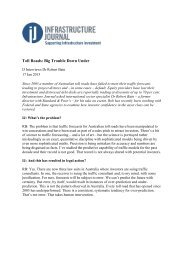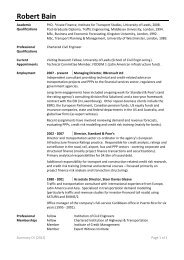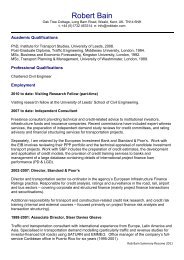Disincentivising overbidding for toll road concessions
Disincentivising overbidding for toll road concessions
Disincentivising overbidding for toll road concessions
- No tags were found...
You also want an ePaper? Increase the reach of your titles
YUMPU automatically turns print PDFs into web optimized ePapers that Google loves.
A3 │ TRAFFIC AND REVENUE REPORTS: BEST PRACTICE<br />
A31<br />
Traffic and revenue reports:<br />
best practice 132<br />
The following article was written by Robert Bain (RBconsult). It is reproduced here as it offers recommendations<br />
about the structure and content of <strong>toll</strong> <strong>road</strong> traffic and revenue <strong>for</strong>ecasting reports. In line with the general PPP<br />
philosophy, these recommendations focus on the output (the final report), leaving consultants to design their<br />
research and traffic modelling activities as they feel appropriate.<br />
During my years with the Infrastructure Team at Standard & Poor’s and, more recently, running my own technical<br />
consultancy <strong>for</strong> banks and institutional investors, I have reviewed over 100 <strong>toll</strong> <strong>road</strong> traffic and revenue (T&R) study<br />
reports from around the world. Traffic consultants often self-define their work as ‘investment grade’, however my<br />
analysis suggests that this is commonly more of a marketing ploy than a serious attempt to understand and respond<br />
to the needs of potential financiers. The traffic studies themselves typically represent variations on a similar theme –<br />
however the variance in the quality of reporting is staggering. This is unhelpful at a time when international investor<br />
confidence in traffic <strong>for</strong>ecasts is at an all time low.<br />
If <strong>toll</strong> <strong>road</strong>s globally are going to reassert themselves as attractive investment propositions to a b<strong>road</strong> investor base,<br />
project risk and uncertainty needs to be better understood and communicated. Improved study reporting has a<br />
central role to play in that context and those commissioning traffic studies need to be more demanding in their terms<br />
of reference. For too long, the outputs from traffic studies have been dictated by traffic consultants – not their clients.<br />
From my reviews – and from numerous discussions with bankers, bondholders, insurers and fund managers –<br />
recurring reporting deficiencies have emerged. Addressing these deficiencies would go a long way to restoring<br />
investor confidence. The remainder of this article identifies ten simple yet practical ways in which the quality and<br />
transparency of <strong>toll</strong> <strong>road</strong> T&R study reports could be improved.<br />
Clear Presentation of (and Justification <strong>for</strong>) the Assumptions Used<br />
All of the traffic modelling assumptions adopted in a study should be made explicit. This is rarely the case. The<br />
assumptions should be consolidated in a single table <strong>for</strong> easy review, rather than being scattered across different<br />
chapters – and strong empirical evidence (with robust justification) should be provided in support. The implications of<br />
adopting alternative yet still plausible assumption sets on the resulting <strong>for</strong>ecasts should be highlighted. Addressing<br />
these deficiencies would be of considerable benefit to an investor audience.<br />
132 Reproduced with the kind permission of Tollways, the journal of the International Bridge, Tunnel and Turnpike Association (IBTTA).<br />
73






